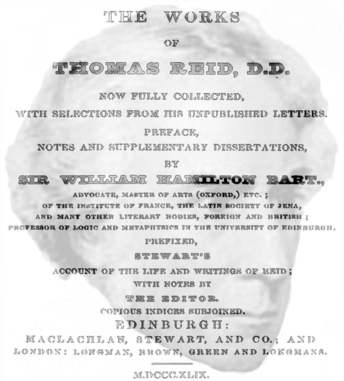William Hamilton1788–1856
Hamilton was the final member of the common-sense school of philosophers based in Edinburgh. He followed its founder, Reid, and his interpreters, Stewart and Thomas Brown. Hamilton was not too charitable to his philosophical forbears, and one historian wryly wrote: “Dugald Stewart corrects Reid, Brown corrects Stewart, and Hamilton corrects everybody”. A flavour of Hamilton’s style can be found in his lectures where even praise of Reid is barbed: “The doctrine of perception may thus be viewed as a cardinal point of philosophy. It is also exclusively in relation to this faculty, that Reid must claim his great, his distinguishing glory, as a philosopher; and of this no one was more conscious than himself”. On Thomas Brown: “Reid had errors enough to be exposed, but Brown has not been so lucky as to stumble even upon one”. Hamilton had a detailed knowledge of Continental philosophy and brought these influences, and particularly the ideas of Kant, to bear on his analysis of mental processes. Nonetheless, the ‘common sense school’ essentially died with Hamilton. One historian of Scottish philosophy gave the following sober appraisal: “I admit that Sir William Hamilton had deeply observed the operations of the mind, and that his lectures contribute more largely to psychology than any work published in his day. But his induction is too much subordinated to logical arrangement and critical rules”. Support for this view is derived largely from the manner in which he elaborated upon the useful concepts he introduced. For example, in preferring the term ‘cognition’ to ‘knowledge’ in his lecture on perception he embarked on a lengthy discourse regarding their grammatical uses. It was in the theatre of the senses that Hamilton advanced understanding of perception in general and the muscle sense in particular. The term “Muskelsinn” had been used by German writers in the eighteenth century, and Hamilton suggested that the idea was described even earlier. Hamilton presented many of his ideas in support of common sense philosophy in lengthy and erudite footnotes to Reid’s works, published in 1846. It is the title page of this book that Hamilton’s portrait is presented.
